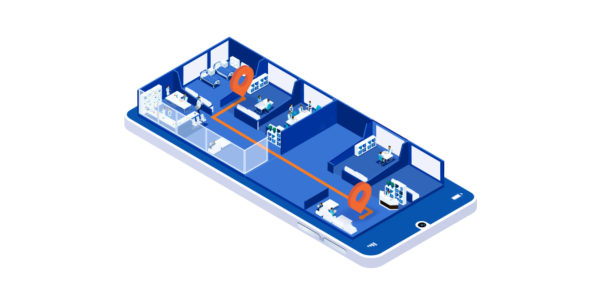The indoor guidance system using QR codes allows users to easily get a map and directions to guide themselves through a building without having to download a mobile app. How does this technology work and what are the benefits?

3D mapping, the basis for the operation of interior guidance
In order to be able to offer interior guidance with QR codes, it is first necessary to create a 3D map of the building concerned. This mapping allows to represent all the spaces and particularities of a covered place so that the guidance is optimal. The smallest detail is important, it is therefore necessary to map the walls, corridors, rooms, but also the stairs and elevators for example.
Once designed, this 3D mapping allows to generate routes in the building in order to optimize the movements. It is only once this mapping is completed that it will be possible to set up the interior guidance with QR codes.

QR codes for quick and easy access
As a reminder, QR codes are a type of barcode that can be scanned with the camera of your smartphone, which then opens a web link or a file.
For this indoor guidance solution, QR codes are generated quickly from Sweepin's back office: up to a hundred can be created for a single building, which are then spread over the entire surface of the building.


In this case, each QR code corresponds to the user's starting position in a building, such as a hospital for example. Once the QR code is scanned by the visitor with his smartphone, the map of the place is displayed on the screen. He is offered to generate an itinerary according to his position (found thanks to the QR code) and the place where he wants to go.
A button "start guiding" is then displayed and the visitor can choose his walking speed to follow the proposed route. He also has the possibility to pause the route at any time.
The availability of QR codes
Using this solution, the provision of QR codes for visitors is essential. It is possible to print them on posters or kakemonos for example, or to generate them on the digital terminals of the building. The main thing is that visitors find them quickly and easily in places that are often very spacious and busy.

Les avantages de cette solution de guidage intérieur
Combining 3D mapping with the use of QR codes has several advantages.
First of all, this solution does not require the prior installation of a mobile application by the visitors and allows them to guide themselves in the building without necessarily having anticipated this route search.
Moreover, the implementation of this guidance system is very simple because it does not require any installation, except for the kakemonos, posters or digital terminals of reception to display the QR codes. This means that the Sweepin team does not have to travel to help set up the service, as everything can be easily indicated remotely if necessary.
Another advantage is that visitors can go directly to the desired location without getting lost in a large structure. The staff also benefits from the reduction of corridor clutter, especially in health care facilities.
Finally, this solution can be adapted to many types of structures with large surfaces, such as healthcare institutions, trade shows, exhibitions, etc. Sweepin was responsible for the 3D mapping at the SANTEXPO trade fair in 2022 and is currently providing this solution to several healthcare institutions in France.
An access to statistics generated by the solution

From the Sweepin back-office, it is possible to access numerous statistics on the use of the solution.
For example, you can see how many QR codes have been scanned since the solution was implemented, but also during the last 24 hours, the last week or the last month.
It is also possible to see which QR codes are the most scanned by visitors, as well as their number of scans.
These statistics make it possible to report on the effectiveness of the solution and to adapt it to the building in which it is deployed.






